Loops: A Love/Hate Relationship
by Joe Moell KØOV
Updated from my Homing In column in the December 1988 issue of 73 Magazine
Small loops are perhaps the simplest direction finding antennas to build. They're easy to mount or they can simply be held out the car window on a mobile transmitter hunt. They can be
made for any of the popular ham bands. In an hour or so you can have
one ready to go. T-hunt loops aren't like the full-wavelength square or delta loops
used by DXers. Loops for RDF are usually less than 1/10
wavelength in circumference. Electrically, they behave more like a
coil than like a wire antenna.
I have a file folder full of articles on simple RDF loops. They have
have appeared everywhere from the major magazines to club newsletters.
It's fun to read the authors' claims. Here's one for two meters that
says, "Throw your competitors for a loop! A little practice will make
you an expert, and you'll be able to invite your fans, family, and
friends into your trophy room..."
These claims are reminiscent of the "hidden antenna" articles where
the author says he worked DXCC in a weekend after hooking his rig to a
downspout through a tuner made of old bedsprings. Time for a
reality check: It just isn't that easy.
Left or Right?
The biggest problem with simple loops is that they're bidirectional.
As you rotate the loop 360 degrees, you get signal peaks when the
plane of the loop is in the direction of the source, and nulls
(minimum signal points) looking through the loop toward the source. The
peaks are broad and the nulls are sharp, so the nulls give greatest
RDF accuracy. But there are two nulls and they're in exactly
opposite directions.
How do you figure out which way to go when the RDF system has 180
degree ambiguity? You could take bearings from two widely separated
locations and triangulate, but that would involve too much time and
mileage. You could circle in from the edge of the hunt boundary area
instead of starting at the center. No, even if the hunt rules allow
it, you'll probably lose in time or mileage because you'll have picked
the most distant edge. Or you could watch to see which way the hunters
with unidirectional antennas start out. But you don't want to follow
them, do you?
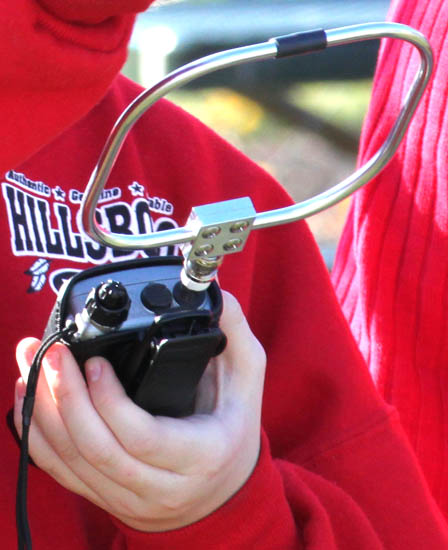
The FHL-VHF bidirectional loop from Arrow Antennas can be used on the two-meter band. It is untuned, so it covers a wide frequency range but has low sensitivity. Mounting it directly on a handi-talkie avoids the problem of feedline pickup. With an inline offset attenuator, it can be very effective for close-in "sniffing," if you know whether the fox is ahead of you or behind you.
Though there are ways to electronically solve the bidirectionality
problem at two meters, the VHF loop designs I've seen in the
publications seldom have such a feature. Parasitic elements like directors and
reflectors will not work on a fractional wavelength loop antenna.
Shielding methods such as screens and metal plates won't make them
unidirectional either.
The most effective way is to add a nondirectional whip to the antenna
system. Then sum the whip and loop outputs with just the right
amplitude and phase relationship to either enhance one lobe or give a
cardioid (heart-shaped) pattern. This loop/sense scheme has been a
standard technique for RDF below 60 MHz for decades. It is tricky at
two meters, but it can be done. An example is on page 27 of "Transmitter Hunting -- Radio Direction Finding Simplified (THRDFS)."
A loop antenna cannot give a good directional null if the signal is also being picked up by the shield of the feedline. It is important to isolate the coax with a balun at the feedpoint of the loop. On two meters, a simple balun is a few turns of the feedline coax wrapped around the handle.
Loops Hate Multipath
It is common in VHF transmitter hunting for the signal to arrive from
more than one direction. This is called "multipath." It occurs
because terrain features such as mountains, hills, and buildings
reflect VHF signals. Good performance in multipath situations is an
important feature of a successful RDF system.
Null-hunting with a loop can be very frustrating when multipath is
present. Referring to the figure below, assume you are proceeding north (upward in the drawing) following a null. Now a signal reflection appears from east or west, where the loop is most sensitive. As you sweep
the loop past the direct signal trying to find the exact null
direction, the null will be filled in by signal arriving from the
reflection. Even if the reflection is much lower in strength than the
direct signal, it may be impossible to get a correct bearing on the
direct signal.
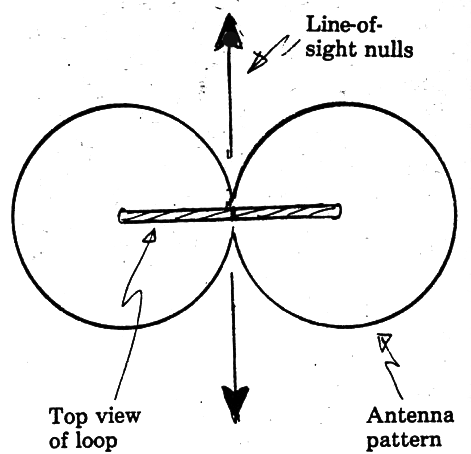
Looking down on a vertically-oriented loop, there are sharp nulls "through the loop" and broad peaks to the sides. Nulls in the loop pattern may be filled in if
multipath is present.
By contrast, hunters using yagis or quads can distinguish the
peaks of direct and reflected signals, so long as there is sufficient
signal level difference. Furthermore, the higher gain and larger
capture area of the beam make it a much better performer than a loop
when the signal is weak.
Forget Loops?
So all those other guys who wrote glowing descriptions of their two
meter loops were wrong? No, just overly enthusiastic. Either they
didn't have serious competition, or else they didn't realize how much
more successful they'd be with a better setup.
Several years ago, Dick Reimer W6ET, knew there was a two-meter
repeater jammer in his neighborhood, because the jammer had a strong
signal on the input. Dick didn't have RDF gear at the time, so he
spent a couple of hours building up a simple 8-inch diameter loop, tuned to resonance with a trimmer capacitor. It
gave good nulls and its 0.3-wavelength size gave it good sensitivity.
The jammer cooperated (unknowingly) by staying on the air and by being
in a location that was free of multipath. W6ET tracked him down in
short order and ended the problem.
That was a situation where a loop can do the job well. But a loop is
not what a serious sport hunter would want as his primary RDF system
on a competitive hunt against experienced hunters. W6ET knew that, so
he later got a commercial Doppler RDF for serious hunting.
As part of my T-hunt talks to local radio clubs, I used to demonstrate
W6ET's loop as an easy way to get started on T-hunt contests. I don't
do that any more. Loops have their place, but competitive two meter mobile
T-hunting around Los Angeles isn't one of them. Signals are too weak
and the hiders usually pick spots in the hills or in urban areas that
make the signal ricochet around like a ping-pong ball.
If you want to get started simply and cheaply in two meter mobile hunting and
you want a fighting chance against "big gun" hunters, my advice is to
skip loops and use a simple quad or beam instead. It's a bit more
work, but there will be no null-fill or bidirectionality problems to
worry about. You'll get lots more signal, too.
Try a Loop on Lower Frequencies
Loops are far more successful on six and ten meters. There is much
less multipath on these bands but signals must be stronger because they must
overcome atmospheric noise to be heard. Six-meter mobile transmitter hunts take place twice a year in southern California. Many of the participants use loops.
The most popular six meter loop is the Army surplus AT-339/PRC from the Korean War era,
available at low cost. Ruggedly built for field use,
it tunes 38 to 55 MHz with a built-in attenuator for strong signals
and a sense circuit to resolve the back/front ambiguity. You can find
other models with a little scrounging, including the older AT-249/GRD,
which also covers the same range. The AT-340/PRC looks just like the
AT-339/PRC, but it's for 20 to 39 MHz, making it suitable for ten and
eleven meter use.
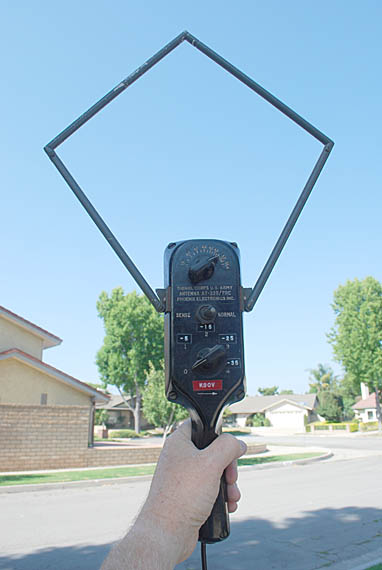
The surplus AT-339/PRC tuned loop is popular for mobile or hand-carried RDF on six meters. It includes sense circuitry to resolve the 180-degree ambiguity.
Loops on Lower Frequencies
Most mobile transmitter hunts in the 1950s were on the 75-meter band. Nowadays, many championship radio-orienteering events take place on 80 meters. Almost all competitors use loop antennas. Typically they are salad-plate sized with several turns of wire on a frame or inside a circular tube, tuned to resonance with a variable capacitor. They have a vertical sense antenna that resolves the 180-degree ambiguity. More compact RDF sets for 80 meters have the loop wire wound on a ferrite rod.
Multiturn loops are popular for receiving and RDF on frequencies from the AM broadcast band through 20 meters. Examples are loops for RDF on marine radio frequencies and the ferrite loop antenna on a pocket transistor radio. These loops have good directional nulls on groundwave signals, but the null is much less prominent and sharp on skywave signals. RDF on the MF/HF bands with loops is thoroughly covered in Chapter 17 of THRDFS.
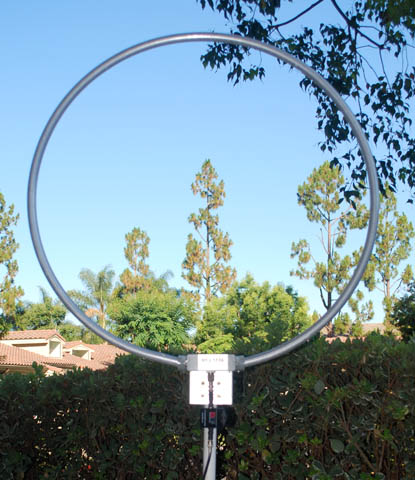
The MFJ-1886 3-foot diameter untuned receiving loop gives good bi-directional nulls on ground-wave signals from below the AM broadcast band up into the HF bands. It has a built-in broadband RF preamplifier to make up for its low inherent sensitiviey. The little black box inline with the coax output is a DX Engineering DXE-RXFC-75 common-mode choke to keep feedline pickup from injecting signals and noise, which would degrade the nulls.
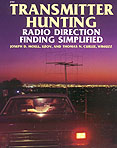 Text and photos © 1998 and 2025 Joseph D. Moell. All rights reserved.
Text and photos © 1998 and 2025 Joseph D. Moell. All rights reserved.
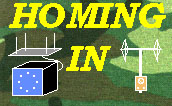 Back to the Homing In home page
Back to the Homing In home page
This page updated 10 July 2025





